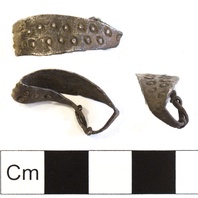
Viking Objects
Stamped Finger Ring (NCL-90DD85)
A silver finger ring made from a sheet of silver cut to size featuring circular punched decoration. Rings like this with knotted ends are typically Scandinavian.
Read More
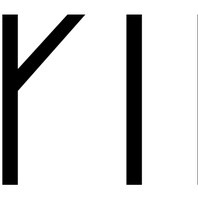
Viking Names
Viking
The male name Víkingr is recorded in some eighteen Viking Age runic inscriptions from Denmark and Sweden, and there is evidence it was used in Norway in the Viking Age and even later. It probably derives from the appellative (common noun) víkingr, the meaning of which varies through time and in the different sources. In Lincolnshire, the place-name Wickenby is formed of either the name or the appellative plus Old Norse -by ‘farm, settlement’. In Leicestershire, the element is combined with Old English tun in Wigston Magna (while Wigston Parva has a quite different origin), and is thus a hybrid name. In this case, the parallels with other hybrid names suggest that the personal name is more likely than the appellative as the first element.
Read More
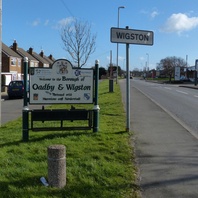
Viking Names
Wigston Magna
Wigston Magna, in the Guthlaxton Hundred of Leicestershire, is an Anglo-Scandinavian hybrid from the Old Norse male personal name Víkingr and the Old English element tun ‘an enclosure; a farmstead; a village; an estate’. Alternatively the first element might be the Old Norse appellative víkingr ‘a viking’, the probably source of the personal name. It has also been suggested that the first element may be the Old English male personal name Wicing or Old English wicing ‘a pirate, a viking’; however, these suggestions are doubtful because the length of the initial vowels of these elements are uncertain, therefore, the Old Norse male personal name is generally accepted as the first element. The Medieval Latin affix Magna ‘big, great’ arose when there was confusion between forms from Wigston Magna and Wigston Parva, which have different etymologies and development, around the the sixteenth century. Some forms of the name also have the affix with two steples because Wigston Magna possessed two medieval churches. Wigston Magna is also known as Wigston and is a joint parish with Oadby.
Read More
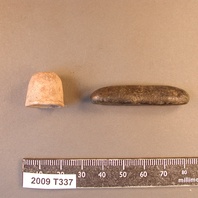
Viking Objects
Breedon Silver Ingot (X.A208.2010.0.0)
A cast silver ingot of typical Viking type. The photograph shows it alongside a lead gaming piece of a type that is increasingly being found within the Danelaw. This ingot could have been used as bullion in payments or trade transactions, as well as a source of metal for jewellery making. This particular ingot has slight irregularities from being made in an open mould and has two testing nicks on one edge. The Vikings arriving in England had a bullion economy where they paid for goods with silver that was weighed to an amount agreed between the buyer and the seller. Hacksilver and silver ingots are the most common evidence for their bullion economy. It took some time for the Scandinavian settlers to adopt a monetary economy like that of the Anglo-Saxons, and both systems were used simultaneously for a while before they fully adopted the new system. They were familiar with monetary economies but they treated coins as just another form of silver before adoption of a monetary economy.
Read More
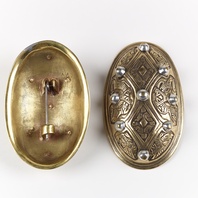
Viking Objects
Reproduction Oval Brooches
Oval brooches were used to fasten dresses in the Viking Age. They are diagnostically Scandinavian and indicate a Scandinavian identity wherever they are found. This pair of brooches is a reproduction of a pair found at Adwick le Street near Doncaster. The mismatched pair were buried with a Norwegian woman who died within a generation of the arrival of the Great Army in the mid-ninth century. Scandinavian brooches came in a variety of sizes and shapes which included disc, trefoil, lozenge, equal-armed, and oval shapes. The different brooch types served a variety of functions in Scandinavian female dress with oval brooches typically being used as shoulder clasps for apron-type dresses and the rest being used to secure an outer garment to an inner shift. Anglo-Saxon brooches do not match this diversity of form with large disc brooches being typical of ninth century dress styles with smaller ones becoming more popular in the later ninth and tenth centuries. However, since disc brooches were used by both Anglo-Saxon and Scandinavian women they are distinguished by their morphology. Scandinavian brooches were typically domed with a hollow back while Anglo-Saxon brooches were usually flat. Moreover, Anglo-Saxon brooches were worn singly without accompanying accessories.
Read More
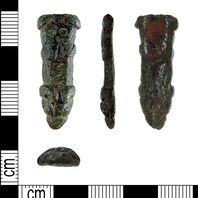
Viking Objects
Copper-Alloy Strap-End (DENO-E40172)
An incomplete copper-alloy strap-end decorated with zoomorphic motifs and stylised human or animal head. It has been identified typologically as belonging to Thomas Class B Type 4.
Read More
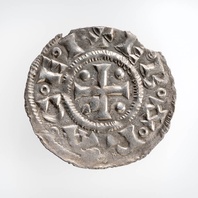
Viking Objects
Northumbrian Viking Penny (CM.952-2000)
This Sword St. Peter type silver penny is not associated with any particular ruler but was minted in the Viking kingdom of Northumbria. The coin features a sword image which is usually considered to represent the sword of St Peter, whose name features on the same side of the coin, and a hammer which is often taken to be Thor’s hammer, thus mixing the iconography of the Christian and Norse religions. It was found as part of the Thurcaston hoard which was probably buried c.923-925 CE, approximately five years after Leicester had been retaken by Mercia (c.918). The coins in the hoard are Anglo-Saxon, Arabic and Danelaw issues, showing the wide-ranging contacts between societies at this time. After the establishment of the Danelaw, some Viking leaders decided to mint their own coins to solidify their legitimacy in the eyes of the local populace. This created a hybrid economy where some members of the Danelaw used bullion and others used coins. The bullion economy resulted in some coins being cut into pieces to pay for items.
Read More
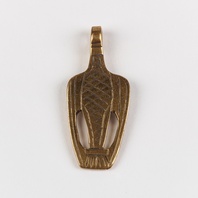
Viking Objects
Reproduction Bird Pendant
A reproduction bird pendant based on one found at Langford, Nottinghamshire. The nearest parallel to this type of brooch is one from Yaroslavl in Russia. The bird symbol, very similar to the one depicted on this pendant, was used by the Rurik dynasty which had started the conquest of Slavic lands in the mid 9th century and later formed the polity of Rus’. With some exceptions, pendants were generally worn by women as an accessory to Scandinavian dress.
Read More
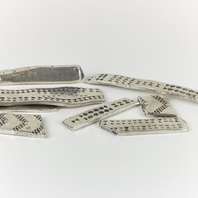
Viking Objects
Reproduction Hacksilver
These white metal reproductions of Viking Age hacksilver are typical of hacksilver finds. The Scandinavians had a bullion economy in the Viking Age and paid for goods by weight of silver rather than by using coins with a set monetary value. Arm rings are one example of wearable wealth that could be cut up to pay for goods when needed.
